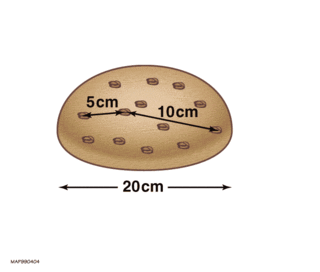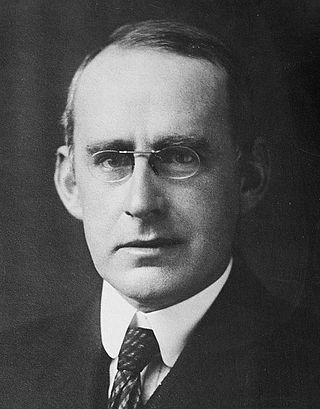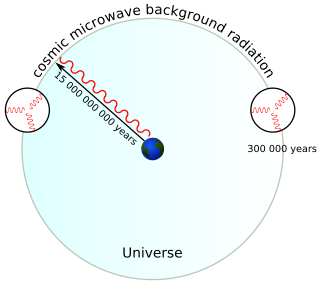
Hubble's law, also known as the Hubble–Lemaître law, is the observation in physical cosmology that galaxies are moving away from Earth at speeds proportional to their distance. In other words, the farther they are, the faster they are moving away from Earth. The velocity of the galaxies has been determined by their redshift, a shift of the light they emit toward the red end of the visible spectrum.

In physics, the fine-structure constant, also known as the Sommerfeld constant, commonly denoted by α, is a fundamental physical constant which quantifies the strength of the electromagnetic interaction between elementary charged particles.
The Hartree atomic units are a system of natural units of measurement which is especially convenient for calculations in atomic physics and related scientific fields, such as computational chemistry and atomic spectroscopy. They are named after the physicist Douglas Hartree. Atomic units are often abbreviated "a.u." or "au", not to be confused with the same abbreviation used also for astronomical units, arbitrary units, and absorbance units in other contexts.
The Eddington luminosity, also referred to as the Eddington limit, is the maximum luminosity a body can achieve when there is balance between the force of radiation acting outward and the gravitational force acting inward. The state of balance is called hydrostatic equilibrium. When a star exceeds the Eddington luminosity, it will initiate a very intense radiation-driven stellar wind from its outer layers. Since most massive stars have luminosities far below the Eddington luminosity, their winds are mostly driven by the less intense line absorption. The Eddington limit is invoked to explain the observed luminosity of accreting black holes such as quasars.
In physics, a dimensionless physical constant is a physical constant that is dimensionless, i.e. a pure number having no units attached and having a numerical value that is independent of whatever system of units may be used.

In astrophysics, the Eddington number, NEdd, is the number of protons in the observable universe. Eddington originally calculated it as about 1.57×1079; current estimates make it approximately 1080.

The horizon problem is a cosmological fine-tuning problem within the Big Bang model of the universe. It arises due to the difficulty in explaining the observed homogeneity of causally disconnected regions of space in the absence of a mechanism that sets the same initial conditions everywhere. It was first pointed out by Wolfgang Rindler in 1956.

In particle physics, the Klein–Nishina formula gives the differential cross section of photons scattered from a single free electron, calculated in the lowest order of quantum electrodynamics. It was first derived in 1928 by Oskar Klein and Yoshio Nishina, constituting one of the first successful applications of the Dirac equation. The formula describes both the Thomson scattering of low energy photons and the Compton scattering of high energy photons, showing that the total cross section and expected deflection angle decrease with increasing photon energy.
Relativistic quantum chemistry combines relativistic mechanics with quantum chemistry to calculate elemental properties and structure, especially for the heavier elements of the periodic table. A prominent example is an explanation for the color of gold: due to relativistic effects, it is not silvery like most other metals.
A variable speed of light (VSL) is a feature of a family of hypotheses stating that the speed of light may in some way not be constant, for example, that it varies in space or time, or depending on frequency. Accepted classical theories of physics, and in particular general relativity, predict a constant speed of light in any local frame of reference and in some situations these predict apparent variations of the speed of light depending on frame of reference, but this article does not refer to this as a variable speed of light. Various alternative theories of gravitation and cosmology, many of them non-mainstream, incorporate variations in the local speed of light.
In atomic physics, the electron magnetic moment, or more specifically the electron magnetic dipole moment, is the magnetic moment of an electron resulting from its intrinsic properties of spin and electric charge. The value of the electron magnetic moment is −9.2847647043(28)×10−24 J⋅T−1. In units of the Bohr magneton (μB), it is −1.00115965218059(13) μB, a value that was measured with a relative accuracy of 1.3×10−13.
In physics, there is a speculative hypothesis that, if there were a black hole with the same mass, charge and angular momentum as an electron, it would share other properties of the electron. Most notably, Brandon Carter showed in 1968 that the magnetic moment of such an object would match that of an electron. This is interesting because calculations ignoring special relativity and treating the electron as a small rotating sphere of charge give a magnetic moment roughly half the experimental value.
The cosmic neutrino background is the universe's background particle radiation composed of neutrinos. They are sometimes known as relic neutrinos.
The Einstein–de Haas effect is a physical phenomenon in which a change in the magnetic moment of a free body causes this body to rotate. The effect is a consequence of the conservation of angular momentum. It is strong enough to be observable in ferromagnetic materials. The experimental observation and accurate measurement of the effect demonstrated that the phenomenon of magnetization is caused by the alignment (polarization) of the angular momenta of the electrons in the material along the axis of magnetization. These measurements also allow the separation of the two contributions to the magnetization: that which is associated with the spin and with the orbital motion of the electrons. The effect also demonstrated the close relation between the notions of angular momentum in classical and in quantum physics.
In cosmology, baryon acoustic oscillations (BAO) are fluctuations in the density of the visible baryonic matter of the universe, caused by acoustic density waves in the primordial plasma of the early universe. In the same way that supernovae provide a "standard candle" for astronomical observations, BAO matter clustering provides a "standard ruler" for length scale in cosmology. The length of this standard ruler is given by the maximum distance the acoustic waves could travel in the primordial plasma before the plasma cooled to the point where it became neutral atoms, which stopped the expansion of the plasma density waves, "freezing" them into place. The length of this standard ruler can be measured by looking at the large scale structure of matter using astronomical surveys. BAO measurements help cosmologists understand more about the nature of dark energy by constraining cosmological parameters.
In physics the Stoney units form a system of units named after the Irish physicist George Johnstone Stoney, who first proposed them in 1881. They are the earliest example of natural units, i.e., a coherent set of units of measurement designed so that chosen physical constants fully define and are included in the set.
In cosmology, recombination refers to the epoch during which charged electrons and protons first became bound to form electrically neutral hydrogen atoms. Recombination occurred about 378,000 years after the Big Bang. The word "recombination" is misleading, since the Big Bang theory doesn't posit that protons and electrons had been combined before, but the name exists for historical reasons since it was named before the Big Bang hypothesis became the primary theory of the birth of the universe.
In particle physics and physical cosmology, Planck units are a system of units of measurement defined exclusively in terms of four universal physical constants: c, G, ħ, and kB. Expressing one of these physical constants in terms of Planck units yields a numerical value of 1. They are a system of natural units, defined using fundamental properties of nature rather than properties of a chosen prototype object. Originally proposed in 1899 by German physicist Max Planck, they are relevant in research on unified theories such as quantum gravity.
Electric dipole spin resonance (EDSR) is a method to control the magnetic moments inside a material using quantum mechanical effects like the spin–orbit interaction. Mainly, EDSR allows to flip the orientation of the magnetic moments through the use of electromagnetic radiation at resonant frequencies. EDSR was first proposed by Emmanuel Rashba.
The term physical constant expresses the notion of a physical quantity subject to experimental measurement which is independent of the time or location of the experiment. The constancy (immutability) of any "physical constant" is thus subject to experimental verification.






















